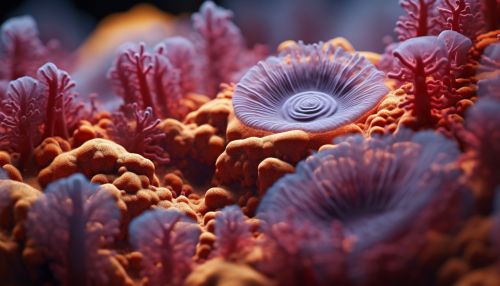Haloarchaea
Introduction
Haloarchaea (also known as halophilic archaea) are a group of archaea, and part of the family Halobacteriaceae. They are an ancient group of organisms that have evolved to survive in high salt concentrations, some of which can be found in the most inhospitable environments on Earth, such as the Great Salt Lake in Utah, and the Dead Sea. These organisms have a unique biochemistry which allows them to survive in these extreme conditions, making them a subject of interest for scientific research.


Classification and Evolution
Haloarchaea belong to the domain Archaea, one of the three main branches of life along with Bacteria and Eukarya. Within the Archaea, they are part of the phylum Euryarchaeota. The family Halobacteriaceae includes over 50 recognized species, all of which are considered halophiles due to their ability to thrive in high salt environments.
The evolution of haloarchaea is a topic of ongoing research. It is believed that they have evolved from non-halophilic ancestors, adapting to the high salt concentrations of their environment over time. This adaptation has involved changes at the genetic, biochemical, and structural levels, allowing these organisms to not only survive, but thrive in conditions that would be lethal to most other forms of life.
Biochemistry
The biochemistry of haloarchaea is unique and complex, allowing them to survive in environments with salt concentrations up to ten times that of seawater. They have developed several adaptations to cope with these conditions, including the synthesis of compatible solutes, the accumulation of potassium ions, and the production of extremely stable proteins.
One of the key adaptations is the use of compatible solutes, small organic molecules that can be accumulated in high concentrations without disrupting cellular processes. These solutes, which include ectoine and trehalose, help to balance the osmotic pressure between the cell and its environment, preventing the cell from dehydrating in the high salt conditions.
In addition to compatible solutes, haloarchaea also accumulate high concentrations of potassium ions inside their cells. This adaptation allows them to maintain an internal ionic environment that is compatible with their enzymatic and metabolic processes, despite the high external salt concentration.
The proteins of haloarchaea are also unique, being extremely stable and resistant to the denaturing effects of high salt concentrations. These proteins, known as halophilic proteins, have a higher proportion of acidic amino acids, allowing them to maintain their structure and function in the high salt environment.
Ecology
Haloarchaea are found in a variety of high salt environments around the world, including salt pans, saline soils, and hypersaline lakes. They play a key role in the biogeochemical cycling of elements in these environments, particularly the cycling of carbon, nitrogen, and sulfur.
In addition to their role in biogeochemical cycling, haloarchaea are also involved in the formation of certain types of rock and mineral deposits. For example, they are known to contribute to the formation of evaporite deposits, which are formed by the evaporation of saline water.
Despite the extreme conditions in which they live, haloarchaea form complex communities with other microorganisms, including other archaea, bacteria, and eukaryotes. These communities are often characterized by a high degree of metabolic interdependence, with different species performing different roles in the cycling of nutrients.
Applications
Due to their unique biochemistry and ability to survive in extreme conditions, haloarchaea are of interest for a variety of applications. For example, their stable proteins are being investigated for use in industrial processes, such as the production of biofuels and bioplastics. Their ability to accumulate compatible solutes is also of interest for the development of stress-tolerant crops.
In addition, haloarchaea are being studied for their potential use in bioremediation, the use of organisms to clean up environmental contamination. For example, some species of haloarchaea are capable of reducing selenium compounds, which are toxic to many organisms, to less toxic forms.
